Stortorget ’’The Big Square’
This is the city’s oldest square, it was here when Stockholm was founded somewhere between year 1187 and 1252.
The square’s history
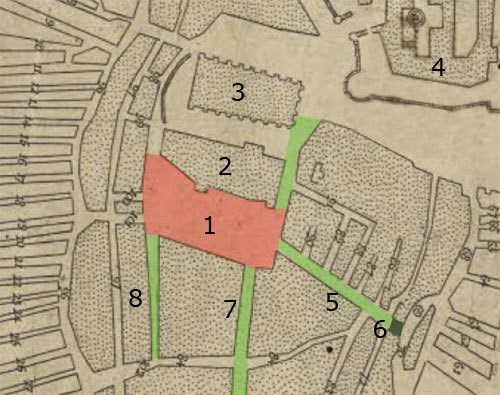
The Big Square is Stockholm’s oldest square; it came to when the conurbation started at the top of Stadsholmen sometime between 1187 and 1252. The map above is from the year 1547 (the oldest map of Stockholm).
-
The Big Square with red color
-
Town Hall
-
The Big Church
-
The Castle ‘’Tre Kronor’’
-
Köpmangatan
-
Köpmanporten (a gate)
-
Svartmangatan
-
Skomakargatan
The Big Square is in the same spot and almost the same size as it was in the Middle Ages, it has changed very little since.
During the Middle Ages and until year 1523 The Big Square was the most important square in the city for most things, they had a marketplace and the council hall where they also kept people who were arrested and waited on their sentence. It also had the town’s most important wells and was the place where only the most powerful and rich could afford to live.
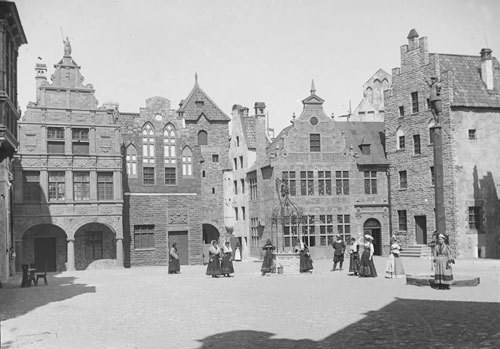
The picture above shows an example how it could look a normal day at the square during the Middle Age. (Picture from Stockholm’s art show 1897.)
As the city grew the square got less important as a marketplace and after 1849 only dairy products were allowed to be sold here. Today the only thing left of the marketplace is the annual Christmas market that takes place for a few weeks before Christmas.
The year of 1520 occurred something that today is known as Stockholms blodbad (blood bath). It was the union king Kristian II that had 92 people executed, most of them beheaded on this square. But it was not the first occasion of executions; the first documented time in the books was the year 1280 when king Magnus Ladulås had rioters killed, Jöns Karlsson, Börje Filipson and Jöns Filipson. The executing’s continued on the square multiple times (including Erik Puke the year of 1437).
The council hall was the city’s most important building until 1732. It was where the city’s councilors met and made the decisions for the whole city. Because the leading men and traders lived there it also became the city’s trade and financial center until the National bank was built at Järntorget (‘’The Iron Square’’) in 1682.
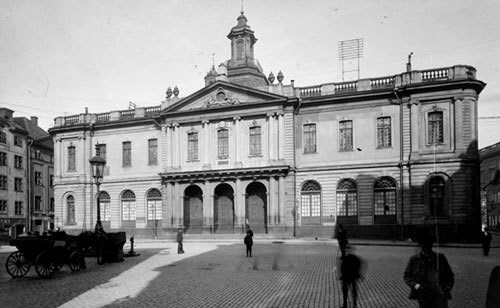
In 1776 the new Börshus (‘’Stock Exchange House’’) was built in the north end of the square (see picture above from 1896) where the council hall previously was. The architects Johan Eberhard Carlberg and Erik Palmstedt designed the building. It was a commodity exchange with mostly iron, copper, silver and gold. Since the year 1786 it is the Svenska Akademin (‘’Swedish Academy’’ who for instance gives out the Nobel price in litterateur) residence on the upper floor. It has an inscription that says ‘’Svenska Akademin’’ on the front of the building, over the window on the second floor.
The Bloodbath
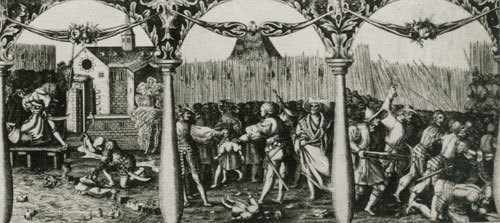
It was the year 1520 in September that the union king Kristian II successfully got through the town gate in to Stockholm with his foreign soldiers. He got crowned King of Sweden in November, it took place in the Storkyrkan (‘’The Big Church’’). After the crowning there was suppose to be a celebration for three days. The 7th of November they celebrated but the 8th Kristian II accuse a number of Swedish people for treason and it ended in a blood bath. 82 people were beheaded in the northwest corner of the square, by the alley Trångsund. Another 10 people was also hanged, but not on the square. It was said that the blood floated alongside Kåkbrinken and towards Väterlånggatan further down to the lake Mälaren.
The Pump
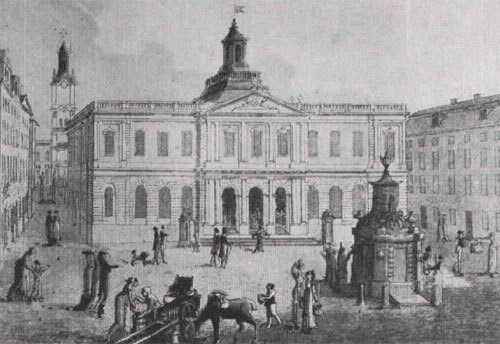
On The Big Square there is a pump with drinkable water. Today it is connected to the normal water supply that goes to the households as well. The pump has been there since the Middle Age, it was one of the town’s first fresh water sources. But not this particular well, it was rebuilt the year of 1778 designed by Erik Palmstedt.
Cannonball
There is a cannonball on The Big Square or rather on the end of the house on the south side of the square, towards Skomakargatan. It has been there for hundreds of years and is said to have come from when Gustav Vasa occupied the city and drove away Kristian II. It was then when Sweden left the hated union and once again became a free country with our own king and government.
Maybe that is not the whole truth but the legend. This is what truly happened: The furniture dealer Fredrik Christian Hans Grevesmuhl had in 1795 a ‘’Gustavianskt’’ house on the corner of the square and had the cannonball built in on purpose. That was approximately 250 years after the event actually occurred. His motive was to create a monument of Gustav Vasa’s siege that forced Kristian II to surrender and led to a free Sweden from the union time, and a kind of revenge for the blood bath he caused in 1520. Because of the cannonball the house sometimes is called Rövarkulan (‘’Rober ball’’) or just Huset kulan (‘’House ball’’).
Last but not least, to be able to log this Virtual Cache as Found you have to go to the coordinates and take a photo of you or your GPS with the canonball on the house visible in the background and post it together with your log. If you log it without the requirements it will be deleted.
Virtual Reward - 2017/2018
This Virtual Cache is part of a limited release of Virtuals created between August 24, 2017 and August 24, 2018. Only 4,000 cache owners were given the opportunity to hide a Virtual Cache. Learn more about Virtual Rewards on the Geocaching Blog.